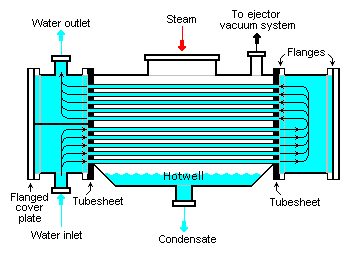What is a surface condenser?
A device for condensing steam in which the steam and the water do not come in contact with each other. ( shell tube exchanger) Describe the water and steam flow in a surface condenser? The water flows through the tubes while the exhaust steam flows over the outside surface of the tubes and is there condensed. What are the advantages of the surface condenser as compared with jet condensers? It permits the use of impure or salt water (sea water) without bringing them in contact with the condensed steam, hence the condensate is available for use as boiler feed. What materials are used for condenser tubes? The material most commonly used Muntz metal for fresh water and Admiralty metal for salt water, pure copper is being used for exceptional conditions.
STEAM SURFACE CONDENSER OPERATION
The main heat transfer mechanisms in a surface condenser are the condensing of saturated steam on the outside of the tubes and the heating of the circulating water inside the tubes. Thus for a given circulating water flow rate, the water inlet temperature to the condenser determines the operating pressure of the condenser. As this temperature is decreased, the condenser pressure will also decrease. As described above, this decrease in the pressure will increase the plant output and efficiency. Due to the fact that a surface condenser operates under vacuum, noncondensable gases will migrate towards the condenser. The noncondensable gases consist of mostly air that has leaked into the cycle from components that are operating below atmospheric pressure (like the condenser). These gases can also result from caused by the decomposition of water into oxygen and hydrogen by thermal or chemical reactions. These gases must be vented from the condenser for the following reasons: The gases will increase the operating pressure of the condenser. Since the total pressure of the condenser will be the sum of partial pressures of the steam and the gases, as more gas is leaked into the system, the condenser pressure will rise. This rise in pressure will decrease the turbine output and efficiency.
• The gases will blanket the outer surface of the tubes. This will severely decrease the heat transfer of the steam to the circulating water. Again, the pressure in the condenser will increase.
• The corrosiveness of the condensate in the condenser increases as the oxygen content increases. Oxygen causes corrosion, mostly in the steam generator. Thus, these gases must be removed in order to extend the life of cycle components. 
Where is an evaporative condenser used in practice?
Answer: In those cases where the shortage of cooling water is acute.
What should be the basic criteria for an efficient steam condenser?
Answers:
Maximum amount of steam condensed per unit area of available heat transfer surface.
Minimum quantity of circulating coolant required.
Minimum heat transfer surface required per kW capacity
Minimum power drawn by the auxiliaries.
Why must a vacuum be maintained in the steam condenser?
Answers:
By maintaining a vacuum in the steam condenser, the efficiency of the steam-power plant can be increased as greater the vacuum in the system, greater will be the enthalpy drop of steam. Therefore, more work will be available per kg of steam condensing.
Secondly, the non-condensate (air) can be removed from the condensate-steam circuit by pulling and maintaining a vacuum in the steam side. Therefore, the condensate can be used as boiler feed.
What are the limitations of a surface condenser?
Answers:
It is very bulky and as such requires more floor space.
Its manufacturing, running and maintenance costs are high.
What should be the requirements of an ideal surface condenser used for steam power plants?
Answers:
Uniform distribution of exhaust steam throughout the heat transfer surface of the condenser.
Absence of condensate sub cooling.
There should not be any leakage of air into the condenser.
There should not be any tube leakage.
The heat transfer surface in contact with cooling water must be free from any deposit as scaling reduces the efficiency of heat exchangers.
Goto Page 3 of Steam Condensers |